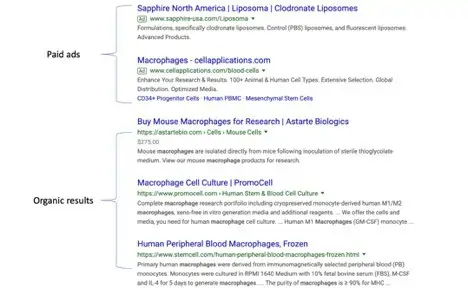
They start as non-believers stating their product or service is so “out there” that no one would ever search for it online.
I’ve won many free lunches, because Google gets 5.6 billion search queries every day, and searchers enter esoteric phrases looking for specific answers.
What is an organic search ranking?
When a search engine, such as Google or Bing, shows search results, it lists two types: organic and paid. Organic search results are the web page listings that most closely match the user’s search query based on relevance, site credibility, and many other factors. These are also called “natural” or “free” search results because you don’t pay when a user clicks on them. The organic search listings typically appear after 1-3 paid ads on top.
What are long-tail search phrases?
Long-tail phrases are typically three-to-ten word phrases that are very, very specific to a buyer’s intent to purchase or find detailed information. Of the thousands of search phrases visitors use to find Clarity Quest’s website via organic search every month, “maintaining and enhancing brand loyalty” is a prime example.
Up to 70 percent of all search traffic comes from long-tail key phrases—and many that you rank for will be specifically related to your business.
If you are in a niche field, you can often rank on page one for these long-tail phrases quite easily. And although the traffic volume will be small, the intent of the searcher and conversion probability is high.
For more on long-tail, read “What is the Long Tail and Why Does it Matter for SEO?”
Search ranking successes using long, detailed phrases
Customers find our healthcare marketing agency by Googling “biotech marketing agency,” but they also land on our site by entering:
- Impact of visual communication
- Post-acquisition marketing strategy
- Marketing performance review template
- Globe Newswire versus PR Newswire
- Maintaining and enhancing brand loyalty
One of our clients was acquired by a large healthcare technology enterprise company who found them online. Two customers grew their niche businesses by 5X by optimizing organic search rankings. About 80% of our new business is secured through organic search listing leads.
Getting started with SEO
Building a high-quality SEO program is a marathon, not a sprint. But there are some basic tactics you can employ to start ranking for niche, long-tail phrases which will drive traffic to your site.
Step #1: Build a topic library
The first step to take is to think of all the topics related to your business that might interest a potential buyer. These may be peripheral to your business, but be in the same industry. You want to have content on your site and in your blog that answers questions for buyers and visitors.
Some of the best sources of buyer questions are sales discussions, live chat logs, blog comments, and questions in LinkedIn Groups related to your industry. Setting up Google Search Console for your website can also be a great source of information related to search terms. I got the idea for this blog post after being asked the question on several recent sales calls.
We have a biotech supplier client who sells specialized human cells for research. The sales team provides the digital marketing team with the types of questions customers are asking. Those questions are segmented into categories, and then content related to those terms are added to the blog, the resources section, or product pages. For example, about 150 people per year search for “difference between glycoprotein and proteoglycan” and hit their site.
Step #2: Write content about these topics
Once you have even a few topics or phrases you think will interest buyers, it’s time to start writing and publishing content on your site and social media channels. Every company is guilty of not producing enough content.
Develop some long-form content, like white papers, and some short-form content, such as blog posts and infographics. Add an educational paragraph to your product pages or an FAQ guide to your Ressources section.
Step #3: Promote the content outside of your website
Once you post content to your website, you’ll rank higher for more competitive phrases by getting people to link to the content. You can get backlinks to your content if you promote it in different channels.
Use your content in e-newsletters and pay-per-click campaigns, gauge trade publication interest in editorial coverage, and offer the content to thought leaders in industry groups.
What if we don’t have the resources?
Determining your topics, writing content, and promoting your ideas takes a firm commitment to processes and resources. If you are short on SEO muscle, we can help.



